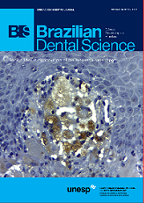Antibiofilm activity in vitro of Rosmarinus officinalis and Syzygium cumini glycolic extracts on Staphylococcus spp. of dentistry interest
DOI:
https://doi.org/10.14295/bds.2017.v20i2.1430Resumo
Objective: The aim of this study was to identify the slime production and evaluate the effects of Rosmarinus officinalis (rosemary) and Syzygium cumini (jambolan) glycolic extracts, and 0.12% chlorhexidine (CHX) in biofilms formed by strains of coagulase-positive Staphylococcus - CPS and coagulase negative Staphylococcus - CNS isolated from the oral cavity. Material and Methods: Slime production was evaluated by two methods: the color of colony presented in Congo red agar, and through the amount of slime adhered to polystyrene. Biofilms were grown in acrylic resin discs immersed in broth, inoculated with microbial suspension (106 cells/ml) and incubated at 37°C/48 h. After formation, the biofilms were exposed for 5 minutes to glycol extracts, CHX or saline solution. The viability of biofilms was determined by counting the colony-forming units per milliliter (CFU/ml) in agar, and analyzed statistically by Tukey test (p <0.05). Results: The strains S. aureus, S. schleiferi and S. epidermidis obtained the highest values of slime adhered to polystyrene. R. officinalis promoted reductions ranging from 12.1% to 78.7% in biofilms formed by isolates of CPS, and 9.2% to 73.7% in the biofilms of CNS. S. cumini reduced 12% to 55.7% in biofilms of CPS, and 7.9% to 71.5% in biofilms of CNS. With exception of S. saprophyticus, glycol extracts produced significant reductions in biofilms. For five isolates studied, R. officinalis produced greater reductions than CHX. Conclusion: R. officinalis and S. cumini showed effective antibiofilm activity against isolates that showed slime production.
Keywords
Biofilm; Rosmarinus officinalis; Slime; Staphylococcus; Syzygium cumini.
Downloads
Downloads
Arquivos adicionais
Publicado
Como Citar
Edição
Seção
Licença
TRANSFERÊNCIA DE DIREITOS AUTORAIS E DECLARAÇÃO DE RESPONSABILIDADE
Toda a propriedade de direitos autorais do artigo "____________________________________________________________________" é transferido do autor(es) para a CIÊNCIA ODONTOLÓGICA BRASILEIRA, no caso do trabalho ser publicado. O artigo não foi publicado em outro lugar e não foi submetido simultaneamente para publicação em outra revista.
Vimos por meio deste, atestar que trabalho é original e não apresenta dados manipulados, fraude ou plágio. Fizemos contribuição científica significativa para o estudo e estamos cientes dos dados apresentados e de acordo com a versão final do artigo. Assumimos total responsabilidade pelos aspectos éticos do estudo.
Este texto deve ser impresso e assinado por todos os autores. A versão digitalizada deverá ser apresentada como arquivo suplementar durante o processo de submissão.




























